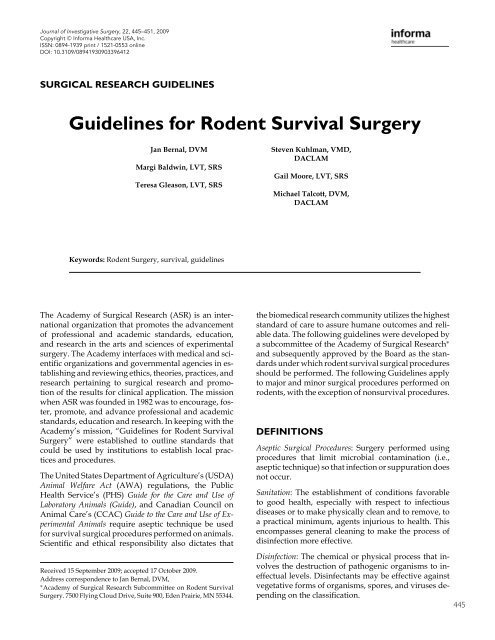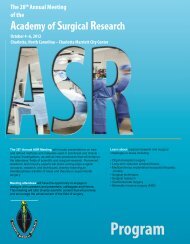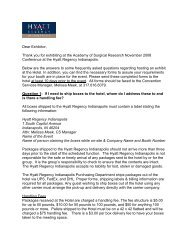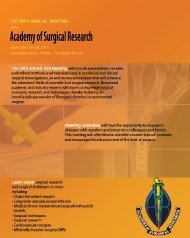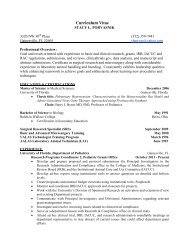Guidelines for Rodent Survival Surgery - Academy of Surgical ...
Guidelines for Rodent Survival Surgery - Academy of Surgical ...
Guidelines for Rodent Survival Surgery - Academy of Surgical ...
Create successful ePaper yourself
Turn your PDF publications into a flip-book with our unique Google optimized e-Paper software.
Journal <strong>of</strong> Investigative <strong>Surgery</strong>, 22, 445–451, 2009Copyright C○ In<strong>for</strong>ma Healthcare USA, Inc.ISSN: 0894-1939 print / 1521-0553 onlineDOI: 10.3109/08941930903396412SURGICAL RESEARCH GUIDELINES<strong>Guidelines</strong> <strong>for</strong> <strong>Rodent</strong> <strong>Survival</strong> <strong>Surgery</strong>Jan Bernal, DVMMargi Baldwin, LVT, SRSTeresa Gleason, LVT, SRSSteven Kuhlman, VMD,DACLAMGail Moore, LVT, SRSMichael Talcott, DVM,DACLAMKeywords: <strong>Rodent</strong> <strong>Surgery</strong>, survival, guidelinesThe <strong>Academy</strong> <strong>of</strong> <strong>Surgical</strong> Research (ASR) is an internationalorganization that promotes the advancement<strong>of</strong> pr<strong>of</strong>essional and academic standards, education,and research in the arts and sciences <strong>of</strong> experimentalsurgery. The <strong>Academy</strong> interfaces with medical and scientificorganizations and governmental agencies in establishingand reviewing ethics, theories, practices, andresearch pertaining to surgical research and promotion<strong>of</strong> the results <strong>for</strong> clinical application. The missionwhen ASR was founded in 1982 was to encourage, foster,promote, and advance pr<strong>of</strong>essional and academicstandards, education and research. In keeping with the<strong>Academy</strong>’s mission, “<strong>Guidelines</strong> <strong>for</strong> <strong>Rodent</strong> <strong>Survival</strong><strong>Surgery</strong>” were established to outline standards thatcould be used by institutions to establish local practicesand procedures.The United States Department <strong>of</strong> Agriculture’s (USDA)Animal Welfare Act (AWA) regulations, the PublicHealth Service’s (PHS) Guide <strong>for</strong> the Care and Use <strong>of</strong>Laboratory Animals (Guide), and Canadian Council onAnimal Care’s (CCAC) Guide to the Care and Use <strong>of</strong> ExperimentalAnimals require aseptic technique be used<strong>for</strong> survival surgical procedures per<strong>for</strong>med on animals.Scientific and ethical responsibility also dictates thatReceived 15 September 2009; accepted 17 October 2009.Address correspondence to Jan Bernal, DVM,∗ <strong>Academy</strong> <strong>of</strong> <strong>Surgical</strong> Research Subcommittee on <strong>Rodent</strong> <strong>Survival</strong><strong>Surgery</strong>. 7500 Flying Cloud Drive, Suite 900, Eden Prairie, MN 55344.the biomedical research community utilizes the higheststandard <strong>of</strong> care to assure humane outcomes and reliabledata. The following guidelines were developed bya subcommittee <strong>of</strong> the <strong>Academy</strong> <strong>of</strong> <strong>Surgical</strong> Research ∗and subsequently approved by the Board as the standardsunder which rodent survival surgical proceduresshould be per<strong>for</strong>med. The following <strong>Guidelines</strong> applyto major and minor surgical procedures per<strong>for</strong>med onrodents, with the exception <strong>of</strong> nonsurvival procedures.DEFINITIONSAseptic <strong>Surgical</strong> Procedures: <strong>Surgery</strong> per<strong>for</strong>med usingprocedures that limit microbial contamination (i.e.,aseptic technique) so that infection or suppuration doesnot occur.Sanitation: The establishment <strong>of</strong> conditions favorableto good health, especially with respect to infectiousdiseases or to make physically clean and to remove, toa practical minimum, agents injurious to health. Thisencompasses general cleaning to make the process <strong>of</strong>disinfection more effective.Disinfection: The chemical or physical process that involvesthe destruction <strong>of</strong> pathogenic organisms to ineffectuallevels. Disinfectants may be effective againstvegetative <strong>for</strong>ms <strong>of</strong> organisms, spores, and viruses dependingon the classification.445
J. Bernal et al.446Sterilization: The process whereby all viable microorganismsand their spores are eliminated or destroyed.The criterion <strong>for</strong> sterilization is the failure <strong>of</strong> organismsto grow if a growth-supporting medium is provided.Sterilization indicators should be used to confirm thatmaterials have undergone proper sterilization.Major <strong>Surgery</strong>: Any surgical intervention that penetratesand exposes a body cavity; any procedure thathas the potential <strong>for</strong> producing permanent physical orphysiological impairment.Minor <strong>Surgery</strong>: Any surgical intervention that neitherpenetrates and exposes a body cavity nor produces permanentimpairment <strong>of</strong> physical or physiological function.<strong>Survival</strong> <strong>Surgery</strong>: Any surgical intervention per<strong>for</strong>medon a live animal under general anesthesia from whichthe animal is expected to recover from anesthesia.Non-survival or terminal surgery: Any surgical interventionwhere the animal is euthanized be<strong>for</strong>e recoveryfrom anesthesia.GENERAL CONSIDERATIONS INRODENT SURGERY1. Rats and mice have a high surface area to body volumeratio and rapid metabolism. Pharmacologicaldoses are usually higher than in larger species.2. Dehydration can occur faster per unit <strong>of</strong> time thanin larger species.3. Rats and mice lose body heat rapidly through hairlessareas and hypothermia during surgery is a frequentcause <strong>of</strong> intra-operative mortality.4. <strong>Rodent</strong>s have limited fat storage and energy reserves,which may contribute to hypothermia.5. Changes in protein metabolism can occur postoperativelyleading to negative nitrogen balance lasting<strong>for</strong> several days. Even minor surgical procedurescan produce prolonged effects.6. Minimizing tissue trauma, preventing infection,controlling post-surgical pain and discom<strong>for</strong>t, andsupporting animals’ nutritional needs will reducethe magnitude <strong>of</strong> metabolic response to surgery.Aseptic TechniqueAccording to the AWA and the Guide, survival surgeryon rodents must be per<strong>for</strong>med using aseptic procedures.Aseptic technique is a set <strong>of</strong> specific practicesand procedures per<strong>for</strong>med under carefully controlledconditions with the goal <strong>of</strong> minimizing contaminationby pathogens. This includes preparation <strong>of</strong> the patient,preparation <strong>of</strong> the surgeon, sterilization <strong>of</strong> instruments,supplies, and implanted materials, and the use <strong>of</strong> otheroperative techniques to reduce the likelihood <strong>of</strong> infection.All individuals per<strong>for</strong>ming surgery must be appropriatelytrained in aseptic techniques to ensure thatgood surgical technique is practiced.<strong>Surgical</strong> Facilities1. <strong>Rodent</strong> surgical procedures do not require a dedicatedfacility, but the area in which surgery is conductedshould be free <strong>of</strong> clutter and disinfected(Table 1) prior to the beginning <strong>of</strong> the surgical session.This area should be located away from air supplyducts or other drafts to minimize hypothermia <strong>of</strong>the animal and limit accumulation <strong>of</strong> dirt and dustcontamination on surfaces.2. Access to this area by persons not directly involvedin the activities should be limited during the surgicalprocedures. For most rodent surgery, the facilitymay be small and simple, such as a dedicated spacein a laboratory appropriately managed to minimizecontamination from other activities in the room duringsurgery. The area should not be used <strong>for</strong> anyother activities during the surgical procedures.3. A clean towel, drape, or diaper can be placed beneaththe animal to provide a warm, s<strong>of</strong>t, absorptivesurface.4. <strong>Rodent</strong> surgical facilities can also include other componentssuch as holding and recovery areas locatedin a quiet area where the animals can be observed.5. Draping accessory and support equipment (e.g.,lights, microscopes, monitoring equipment/leads,anesthesia machine, cautery equipment, etc.) canallow the surgeon to maintain a sterile field ifadjustments in equipment are needed during theprocedure.Pre-Operative Preparation1. Patient Preparationa. Fasting <strong>of</strong> rodents is unnecessary and due to thehigh metabolic rate may deplete energy reservesquickly. <strong>Rodent</strong>s can be acclimated to postoperativediet supplementation (e.g., gels or liquidsintended to deliver analgesics) several days priorto surgery to help prevent neophobia.b. A presurgical evaluation <strong>of</strong> the animal’s health(physical examination) done prior to surgerymay help identify animals that have underlyingdisease conditions and may not be suitable <strong>for</strong>surgery.c. The surgical site(s) must be prepared by closelyclipping and removing the hair. This should bedone in an area separate from where the surgicalprocedures are to be per<strong>for</strong>med. Avoid skin
J. Bernal et al.f. The use <strong>of</strong> a sterile drape over the animal is recommendedto prevent contamination <strong>of</strong> suturematerial and to assure a sterile field at the surgicalsite.g. Sterile, nonmedicated ophthalmic ointmentshould be applied to the eyes to prevent cornealdrying.h. Supplemental heat sources (water circulatingheating pads, <strong>for</strong>ced air-warming blankets, heatlamps, etc.) may be used to help maintain normalbody temperatures depending on the length<strong>of</strong> the surgical procedure. Caution must be usedwith heat lamps to prevent overheating or burningthe animal.2. Surgeon Preparationa. The surgeon shall don a surgical cap/hat, facemask,and a clean lab coat, surgical scrubs, orother garments to cover street clothes.b. Surgeons should wash their hands thoroughlyand dry them prior to putting on sterile gloves.Intra-Operative Procedures1. The animal must be maintained in a surgical plane <strong>of</strong>anesthesia throughout the procedure and vital signs(breathing, skin color, etc.) should be monitored asappropriate.a. New technologies <strong>for</strong> vital sign monitoring inrodents are available including pulse oximetry,ECG, invasive and noninvasive blood pressure,and body temperature-regulated surgical warmingpads.b. Anesthesia assessment (toe pinch reflex, respiratoryrate and quality, corneal reflex, etc.) shouldbe done prior to initiating an incision and routinelythereafter to assure an adequate plane <strong>of</strong>anesthesia.2. Instruments and devices that penetrate the skin orthat will be implanted (needles, suture material,catheters, trocars, telemeters, etc.) must be sterilizedby an approved method (Table 3) prior to the beginning<strong>of</strong> surgery.Table 3. Recommended instrument sterilants (instruments should be cleaned <strong>of</strong> all gross debris prior to sterilization. Followmanufacturer’s recommended concentrations and contact times <strong>for</strong> all sterilizing agents)Agent Examples CommentsMoist heat (steam) Autoclave Effectiveness depend upon temperature, pressure, and time(e.g., 121 ◦ C <strong>for</strong> 15 min vs. 131 ◦ C <strong>for</strong> 3 min)Dry heat Hot bead sterilizer, dry chamber Fast. Instruments must be clean prior to use and must becooled be<strong>for</strong>e contacting tissue. Note that the hot beadsterilizer acts only on the tips <strong>of</strong> instruments and shouldthere<strong>for</strong>e be used to resterilize the working end <strong>of</strong>instruments between surgeries, not as an initial means <strong>of</strong>sterilizationIonizing radiation Gamma radiation Requires special equipment and trainingGas sterilization Ethylene Oxide (ETO) plasma vapor ETO requires 30% or greater relative humidity <strong>for</strong>effectiveness against spores. ETO gas is irritating to tissue;all materials require safe aeration timeHydrogen Peroxide(H 2 O 2 ) & PeraceticAcidSporklenz ○R (full strength)Broad-spectrum. Sporicidal-fungicidal sterilants only withcontact time <strong>of</strong> 11 hr or more. Instruments must be rinsedwith sterile water or saline prior to tissue contactChlorine Chlorine dioxide (Clidox ○R , Alcide ○R ) A minimum <strong>of</strong> 6 hr is required <strong>for</strong> sterilization. Presence o<strong>for</strong>ganic matter reduces activity. Solutions must be freshlyprepared (
ASR <strong>Guidelines</strong>: <strong>Rodent</strong> <strong>Surgery</strong>Table 4. Recommended instrument disinfectants (Follow manufacturer’s recommended concentrations and contact times <strong>for</strong> all disinfectingagents. Note: Trays <strong>of</strong> solution used to disinfect clean instruments between surgeries should be reserved <strong>for</strong> this purpose; instrumentsshould not move in and out <strong>of</strong> these solutions during the surgery, but should be placed in a sterile location in the surgical area or in a separatetray <strong>of</strong> sterile water or saline. Tissues and fluids should be removed from the instruments prior to the disinfection process)Agent Examples CommentsDry heat Hot bead sterilizer Actually a rapid means to resterilize the ends <strong>of</strong> instruments(requiring contact time <strong>of</strong>
J. Bernal et al.Table 5. Recommended closure materials (Note: Always use the smallest gauge suture material that will per<strong>for</strong>m adequately. Cutting orreverse cutting needles provide edges that will cut through dense, difficult to penetrate tissues, such as skin. Taper point or round needleshave no edges to cut through tissues and are used primarily <strong>for</strong> suturing easily torn tissues, such as peritoneum or intestine)MaterialCharacteristics and typical usesVicryl ○R ,Dexon ○RPDS ○R , Maxon ○REthibond ○R , silkEthilon ○R ,Prolene ○RChromic gutStainless steel wound clips orstaplesNexaband ○R and other tissueadhesivesMultifilament. Absorbable in 60–90 days. Used <strong>for</strong> ligation or suturing where absorbablematerial is desirableMon<strong>of</strong>ilament. Absorbable in 6 months. Used <strong>for</strong> ligation or suturing where absorbablematerial is desirable, yet extended wound support is requiredMultifilament. Nonabsorbable. Used <strong>for</strong> ligation or suturing where nonabsorbable materialis desirableMon<strong>of</strong>ilament. Nonabsorbable. Used <strong>for</strong> general skin closureMultifilament. Absorbable. Moderate tissue reactivity, rapid loss <strong>of</strong> strengthNonabsorbable. Requires special instrument <strong>for</strong> removal from skin. Must not be clampedtoo tightAbsorbable and fast. Slightly less tensile strength than standard suture materials(Adapted from the National Institutes <strong>of</strong> Health Intramural Research Program <strong>Guidelines</strong> <strong>for</strong> <strong>Survival</strong> <strong>Rodent</strong> <strong>Surgery</strong> and Washington University <strong>Rodent</strong> <strong>Survival</strong><strong>Surgery</strong> <strong>Guidelines</strong>.)450a. Hypoxia – The airway should be maintained withproper positioning <strong>of</strong> the animal’s head and neckand supplemental oxygen can be given if necessaryvia a mask or tube taped onto the surgery tablein the vicinity <strong>of</strong> the animal’s nose. If the respirationrate falls progressively (40–90 breaths/minacceptable), ventilation may be assisted by gentlecompression <strong>of</strong> the chest at a rate <strong>of</strong> 1 breath/s.In addition, anesthetic antagonist agents (e.g.,naloxone, yohimbine, atipamezole, etc.) or respiratorystimulant (doxapram) can be administeredfollowing the surgical procedure.c. Cardiovascular dysfunction: This is characterizedby poor tissue perfusion. The cause <strong>of</strong> the cardiacimpairment should be identified. For anestheticoverdose, use <strong>of</strong> appropriate antagonist or an anticholinergicagents (e.g., atropine, glycopyrrolate)can reverse the adverse effects. Additionalfluid therapy should be used if there is moderateor significant hemorrhage, and warming padsshould be used to prevent hypothermia.Postoperative Procedures1. The animal should be placed in a warm, dry environmentafter surgery and monitored until it hasrecovered from anesthesia and is ambulatory. Ifanimals are group-housed postoperatively, carefulmonitoring should be done to prevent trauma bycagemates.2. The animal’s eyes should be lubricated again, ifneeded, to prevent drying.3. If applicable, anesthetic/sedative antagonists canbe used to speed anesthesia recovery.4. A patent airway should be maintained by swabbingout the mouth and adjusting body positioningin the recovery cage.5. Fluids, analgesics, and antibiotics should be providedas described in an institutionally approvedanimal protocol.6. A surgical record should be maintained, includingthe type <strong>of</strong> procedure, date per<strong>for</strong>med, surgeon,and any complications.7. Monitoring after anesthesia recovery should includeattention to basic biological functions <strong>of</strong> appetiteand elimination, attitude, activity, appearance,and behavioral signs <strong>of</strong> postoperative pain.8. Postoperative monitoring should include daily assessment<strong>of</strong> the wound <strong>for</strong> postsurgical infections,monitoring <strong>of</strong> the surgical incision, and timely removal<strong>of</strong> skin sutures, clips, or staples (usually in10–14 days).9. The level, type, and duration <strong>of</strong> analgesia will dependupon the procedure per<strong>for</strong>med. Minimallyinvasive procedures generally need less potent orshorter-acting analgesics and animals may respondto a single dose <strong>of</strong> analgesics. More invasive procedures(e.g., laparotomy, orthopedic surgery) mayrequire multiple doses <strong>of</strong> analgesics <strong>for</strong> up to 72hr postoperatively. Specific criteria <strong>for</strong> evaluatingpostoperative pain and provision <strong>of</strong> analgesia must
ASR <strong>Guidelines</strong>: <strong>Rodent</strong> <strong>Surgery</strong>be developed through veterinary consult and describedin the institutionally approved animal protocol.10. Potential signs associated with pain or distress inrodents include the following: Decreased food and water consumption, weightloss. Self-imposed isolation/hiding. Rapid, open mouth breathing. Biting, aggression. Increased/decreased movement. Unkempt appearance, piloerection (rough, dullhair coat). Abnormal posture/positioning (hunched back,head-pressing). Dehydration, skin tenting, sunken eyes. Twitching, trembling.NON-SURVIVAL RODENT SURGERYConsideration should be given to applying the above<strong>Guidelines</strong> when per<strong>for</strong>ming prolonged non-survivalsurgical procedures (6–12 hr), in order to decrease thechance <strong>of</strong> introducing bacteria that may colonize thesurgical site or equipment and produce untoward effectswithin a short period <strong>of</strong> time. At a minimum, asper the Guide, the surgical site should be clipped, thesurgical bench and instruments should be cleaned, andthe surgeon should wear gloves.REFERENCES1. Association <strong>for</strong> Assessment and Accreditation <strong>of</strong> LaboratoryAnimal Care (AAALAC). Connection. 2001 Winter/Spring.2. Animal and Plant Health Inspection Service, USDA. CFR Title9, Subchapter A—Animal Welfare. Washington, DC: U.S. GovernmentPrinting Office; 1991.3. <strong>Academy</strong> <strong>of</strong> <strong>Surgical</strong> Research (ASR). <strong>Guidelines</strong> <strong>for</strong> training insurgical research in animal. J Invest Surg. 1989;2:263–268.4. Atkinson LJ. Berry & Kohn’s Operating Room Technique, 7thed.St. Louis, MO: Mosby; 1992.5. Block SS. Disinfection, Sterilization, and Preservation, 3rd ed.Philadelphia, PA: Lea & Febiger; 1983.6. Boyce J. <strong>Rodent</strong> surgery conference highlights—animal care issues.JAVMA. 1992;201(1).7. Brown MJ, Pearson PT, Tomson FN. <strong>Guidelines</strong> <strong>for</strong> animalsurgery in research and teaching. Am J Vet Res. 1993;54(9):1544–1559.8. Callahan BM, et al. A comparison <strong>of</strong> four methods <strong>for</strong> sterilizingsurgical instruments <strong>for</strong> rodent surgery. Contemp Top.1995;34(2):57–60.9. Canadian Council on Animal Care (CCAC). Guide to the Careand Use <strong>of</strong> Experimental Animals, Vol. 1, 2nd ed. Ontario: CCAC;1993.10. Cunliffe-Beamer TL. Applying principles <strong>of</strong> aseptic surgery torodents. AWIC Newsletter. 1993;4(2):3–6.11. Ethicon Inc. Ethicon Wound Closure Manual. Somerville, NJ:Ethicon Inc. Press; 1994.12. Encyclopedia <strong>of</strong> <strong>Surgery</strong>. Available at: http://www.surgeryencyclopedia.com/13. Flecknell P, Richardson C, Popovic A. Laboratory animals. In:Lumb & Jones’ Veterinary Anesthesia and Analgesia, 4th ed. TranquilliJ, Thurmon J, Grimm K, eds. Ames, IA: Blackwell; 2007.14. Fossum T, et al. Small Animal <strong>Surgery</strong>, 3rd ed. St. Louis, MO:Mosby; 2007.15. Girling S. Rabbit, ferret and rodent anaesthesia. In: Anaesthesia<strong>for</strong> Veterinary Nurses. Welsh E, ed. Ox<strong>for</strong>d: Blackwell Science;2003.16. Harrison SK, Mahnke C. Selection and use <strong>of</strong> disinfectants andsterilants. Contemp Top. 1991;30(2):10–14.17. Hau J, Van Hoosier GL. Handbook <strong>of</strong> Laboratory Animal Science,2nd ed. Boca Raton, FL: CRC Press; 2003.18. Hoover-Plow JL, Clif<strong>for</strong>d AJ. The metabolic effects <strong>of</strong> surgicaltrauma on growing rats. JNutr. 1978 Nov;108(11):1830–1841.19. Knecht CD, Allen AR, Williams DJ, et al. Fundamental Techniquesin Veterinary <strong>Surgery</strong>, 3rd ed. Philadelphia, PA: WB SaundersCompany; 1987.20. Kohn DF, Wixson SK, White WJ, et al. Anesthesia and Analgesiain Laboratory Animals. New York: Academic Press; 1997.21. Lovaglio J, Lawson PT. A draping method <strong>for</strong> improving aseptictechnique in rodent surgery. Lab Animal. 1995;Nov.:23–31.22. National Institutes <strong>of</strong> Health Animal Research Advisory Committee.<strong>Guidelines</strong> <strong>for</strong> <strong>Survival</strong> <strong>Rodent</strong> <strong>Surgery</strong>. 2005. Availableat: http://oacu.od.nih.gov/ARAC/surguide.pdf.23. National Research Council. Guide <strong>for</strong> the Care and Use <strong>of</strong> LaboratoryAnimals. Bethesda, MD: Public Health Service; 1996.24. Orcutt RP. Evaluation <strong>of</strong> disinfectants and sterilants. ContempTop. 1991;30(2):15–17.25. Popp MB, Brennan MF. Long-term vascular access in the rat:importance <strong>of</strong> asepsis. Am J Physiol. 1981;421(4):H606–H612.26. Public Health Service (PHS). Public Health Service Policy on HumaneCare and Use <strong>of</strong> Laboratory Animals. Washington DC: USDepartment <strong>of</strong> Health and Human Services; 1996:28 (pl-99-158,Health Research extension Act, 1985).27. Rutala WA. Association <strong>for</strong> Practitioners in Infection Control,Inc. (APIC) guideline <strong>for</strong> selection and use <strong>of</strong> disinfectants. AmJ Infect Control. 1990;18(2):99–117.28. Rutala WA, Weber DJ. Uses <strong>of</strong> inorganic hypochlorite (bleach)in health-care facilities. Clin Microbiol Rev. 1997;10(4):597–610.29. Sanchez IR, Swaim SF, Nusbaum KE, et al. Effects <strong>of</strong> chlorhexidinediacetate and povidone-iodine on wound healing in dogs.Vet Surg. 1988;17(6):291–295.30. Slatter D. Textbook <strong>of</strong> Small Animal <strong>Surgery</strong>, Vol. 1, 2nd ed.Philadelphia, PA: WB Saunders Company; 1993.31. Swindle M, et al. Preanesthesia, anesthesia, analgesia and euthanasia.In: Laboratory Animal Medicine, Fox J, Lowe F, QuimbyF, eds. San Diego, CA: Academic Press; 2002.32. Wayn<strong>for</strong>th HB. Experimental and <strong>Surgical</strong> Technique in the Rat,2nd ed. London: Academic Press; 1992.451


